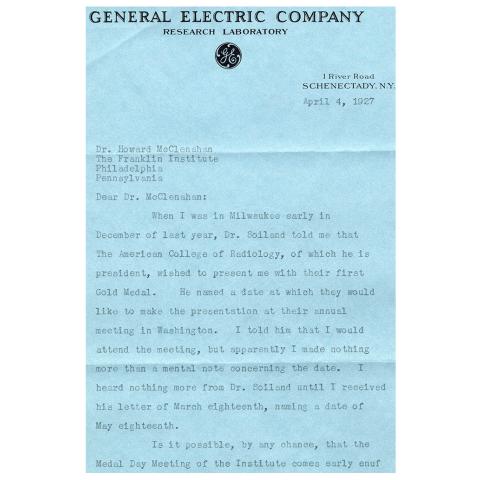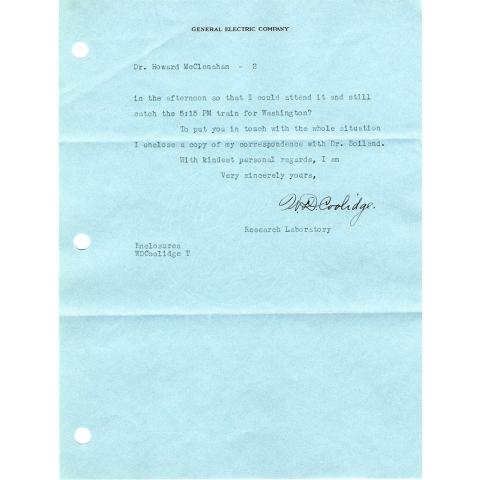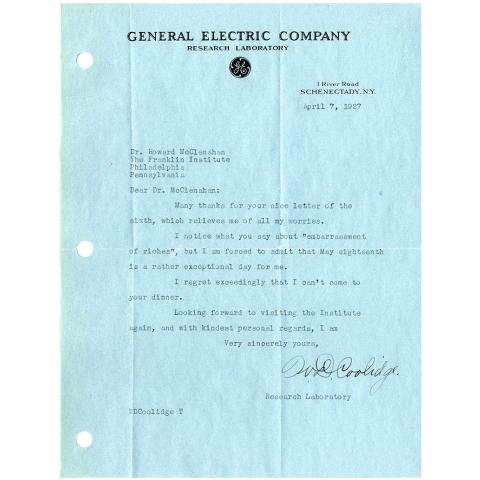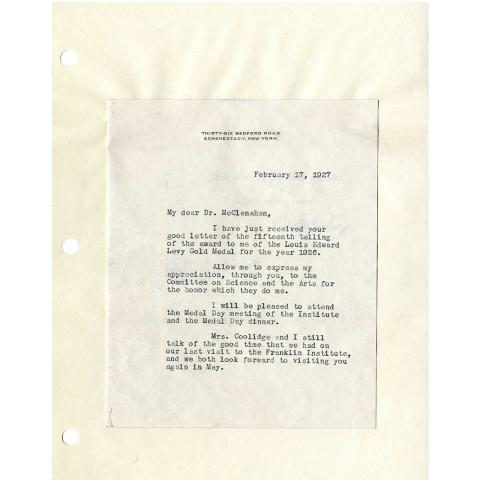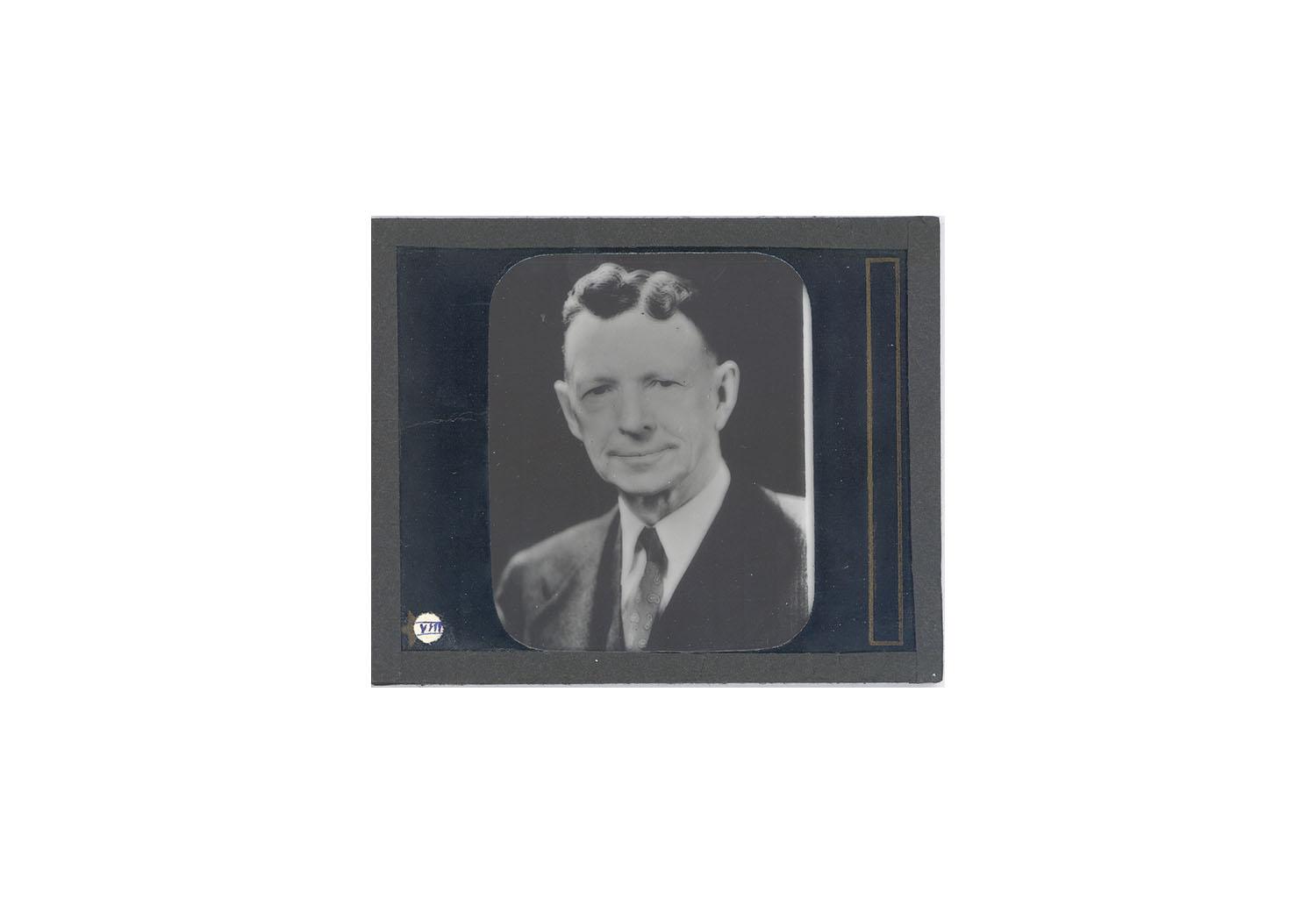
Introduction
After a childhood spent working on his family's farm in Massachusetts, William Coolidge earned a scholarship to M.I.T. and a fellowship at the University of Leipzig. This just happened to be the center of German scientific research at the time. He seemed destined to a brilliant career in scientific invention. In fact, his X-Ray Coolidge Tube radiates brilliantly as his chief legacy.
But who was William D. Coolidge? How did he get the idea for his X-Ray Coolidge Tube?
Pursuit of Opportunity
William David, an only child, was born on October 23, 1873, in Hudson, Massachusetts, to Albert and Amanda Coolidge. Growing up on a farm, he showed a boyhood inclination for photography. He attended a small local school for the first six grades and then Hudson High School. After graduating from Hudson High School with twelve classmates in 1891, he obtained a scholarship to Massachusetts Institute of Technology (MIT) in nearby Boston.
Enrolled in electrical engineering, Coolidge began a lifelong association with Willis R. Whitney, his then chemistry professor. He extended his academic studies to industrial experience with summer work at Westinghouse Electric Company, a young company that had built the first AC electricity generating plant in Great Barrington, Massachusetts, during the infancy of the electrical engineering industry. Coolidge graduated from MIT in 1896 with a more focused interest in physics and laboratory research.
Germany was a center of scientific research at that time and a fellowship at the University of Leipzig gave the opportunity to pursue further academic excellence and to benefit from association with pioneering physicists Paul Drude and Gustav Wiedemann. Wilhelm C. Roentgen visited Leipzig in 1898 and so, coincidentally, Coolidge met personally with the famed discoverer of X-rays whose work he would later integrate and extend in his invention of the Coolidge X-Ray Tube.
Academia and Industry
From Leipzig—his Ph.D. in physics complete—Coolidge returned to teach in the new Physics Department at MIT, conducting research with Arthur A. Noyes, who would go on to become its president and a founder of the California Institute of Technology.
Just a dozen years earlier in 1892, the General Electric Company had been formed with Thomas Edison's company as a part of the original merger. Along with the business consolidation came the commitment to basic, applied industrial research that Edison had established in his Menlo Park installation. The General Electric Research Laboratory was built within the company plant in Schenectady, New York.
Willis Whitney spanned the sometimes conflicting worlds of academia and industry by dividing his time between academic research at MIT and industrial research and applications at General Electric Research Laboratory. Whitney recruited Coolidge in 1905 to join this expanding endeavor at General Electric, and Coolidge spent the rest of his career there.
Improving Performance
On December 30, 1908, Coolidge married Ethel Woodward and they went on to have a daughter, Elizabeth, and a son, Lawrence. Following a serious illness, Ethel died in February, 1915. In 1916, Coolidge remarried. His second wife was Dorothy MacHaffie, the nurse who had come in to help raise his orphaned children.
On arriving at General Electric to join the group of outstanding scientists, Coolidge began working on the search to improve the power performance of the incandescent lamp. The carbon filament in Edison's first commercially produced lamp provided 3 lumens per watt and this figure had been improved by Whitney's development of the GEM (General Electric Metallic) lamp containing a filament of cellulose baked to a high temperature and "metallized."
Further competition to discover improved filament materials came from Europe where energy cost was much higher. Osmium, tantalum, and tungsten were among the more effective candidates tried. Tantalum was found useful only when used with a direct current (DC) power supply. While DC was the chosen method of Thomas Edison in his first Manhattan generating plant, it had been replaced in worldwide acceptance by Tesla's AC (alternating current system).
Coolidge began work on optimizing the use of tungsten as the lamp filament material. Tungsten has the highest melting point and lowest vapor pressure of all metals, and at temperatures over 1650°C has the highest tensile strength. It has excellent corrosion resistance. Coolidge devised a method of treating the raw material before its reduction to the metallic element, and on a method of forging the metal powder to produce a pliable wire. This tungsten filament lamp came to market in 1911 and continues to be widely used today. His experience with the properties of tungsten would serve Coolidge well in his later namesake invention, the Coolidge Tube.
X-Ray Interest
Meanwhile, there was a wide variety of research going on at the General Electric Laboratory, from basic investigations to the development of new electric consumer goods such as blankets and toasters. Coolidge played his part.
Since Roentgen's discovery of X-rays in 1895, the use of X-rays as a diagnostic tool had intrigued the medical community. Coolidge had studied X-rays while in college and met Roentgen in Leipzig; his interest in X-rays persisted.
In his X-ray tube, Coolidge improved on existing models by substituting tungsten as the material in both the heated filament and the target anode and by completely removing ionizing gases from the tubes atmosphere. The result was a consistent and guidable X-ray generator for medical diagnosis and treatment. Further improvements to the 1913 original increased the power of the radiation leading to the non-destructive analytical methods of X-ray crystallography.
Success and Survival
In 1917, as the United States entered World War I, another completely different namesake "C" tube was invented as the General Electric Laboratory collaborated with other companies in the war effort. This prototype device detected and indicated submarine traffic using an arrangement of pipes attached to an acoustic detector.
During the following years, the General Electric Research Laboratory grew in prominence and Coolidge, now Assistant Director, continued his work in the application of X-ray technology. Willis Whitney retired from the laboratory in 1932 and leadership passed to William Coolidge. Coolidge succeeded in maintaining the organization's survival through the difficult economic conditions of the 1930s Depression and positioned it as an important part of the defense effort in World War II, when he played a part in research on the atomic bomb.
Near the end of the war, on December 31, 1944, Coolidge retired from the General Electric Research Laboratory yet maintained his interest in X-ray applications. He lived to be 101 and died on February 4, 1975.
Investigative Tool
In 1895, Wilhelm Conrad Roentgen accidentally observed and—through meticulous scientific investigation—defined a new type of electromagnetic radiation.
While working with a Crookes' Tube cathode ray generator, covered at the time, he noticed a glow produced in an adjacent barium platinocyanide sample. Investigation showed the fluorescence was caused by radiation originating in the Crookes' Tube, which penetrated the covering to reach the platinum compound to glow. Roentgen named his discovery "X-rays."
X-rays are the radiation given off when an electron traveling at high speed strikes a metal target. The rays rank next-to-highest in the electromagnetic spectrum; only gamma rays from nuclear decay have greater penetrating power.
The ability to penetrate tissue to varying degrees makes X-rays an important, non-invasive, investigative tool in diagnosis and treatment in both medicine and in chemical analysis. As X-rays pass through the body, they are blocked, to a greater or lesser degree, by internal organs. A photographic plate placed at the spot where the X-rays exit contains the resulting shadow picture of the internal contents.
Reinvention
In 1895, Thomas Edison took up the investigation of X-ray fluorescence and after his laboratory's typical exhaustive research, produced a fluoroscope in which the target material producing the X-rays was calcium tungstate. William Coolidge redesigned and reinvented the X-ray generator tube by alteration and substitutions of its characteristics.
Earlier tubes contained electrodes and gases which were ionized by high voltage, creating positive ions that impacted the cathode and resulted in a cathode ray beam. The beam was directed at a metal anode with the high energy impact, creating X-rays.
His previous experience and knowledge of the properties of tungsten in light bulb filaments led Coolidge to use it in his improvements to the X-ray generator tube. Tungsten, a transition metal of high atomic weight, has a low vapor pressure, the highest melting point in the periodic table, and good electrical conductivity. In his tube, Coolidge replaced the cathode material with a tungsten filament, substituted tungsten as the target anode material, created a high vacuum in the tube, and cooled the anode.
The new tungsten filament cathode produced energy via the thermionic effect first observed by Thomas Edison during his experiments with light bulb filaments. On being heated, the filament emitted a rapidly increasing number of thermions that adopted the negative charge applied. In the vacuum environment, the stream of thermions, a cathode ray, was attracted to the anode, also made from tungsten. The bombarded anode yielded the X-rays.
These combined modifications gained reliability from the properties of tungsten, controllable intensity from the ability to control the cathode filament temperature, and controllable penetrating power from adjustment of the anode voltage. This marked a great advantage in medical diagnostics and assured the Coolidge Tube's long-lived success.
Acknowledgement
At the age of 100, William David Coolidge was admitted to the Inventors Hall of Fame. Earlier in his life, he was the recipient of many medals and honors. This included the 1926 Edison Medal of the American Institute of Electrical Engineers and the Rumford Prize of the American Academy of Sciences, in addition to the 1926 Howard N. Potts medal described here.
Eighty-three patents were granted to William Coolidge. The most significant being Patent No. 1,082,933 for the method of making tungsten filament for use in the incandescent electric lamp and other purposes (such as X-ray tubes) and Patent No. 1,203,495 for the vacuum tube used in his X-ray generator. His patent concerning ductile tungsten was later invalidated on the basis that the ductile nature of tungsten was an inherent characteristic of the element and so Coolidge chose to refuse the 1926 Edison Prize with the citation "for the origination of ductile tungsten and the fundamental improvement of the X-ray tube." Instead, he received the 1927 Edison Medal for "contributions to the incandescent electric lighting and the X-rays art."
The William D. Coolidge presentation was made possible by support from The Barra Foundation and Unisys.
Read about the Committee on Science and the Arts awarding of the Louis Edward Levy Medal for William Coolidge’s paper “The Production of High-Voltage Cathode Rays Outside of the Generating Tube.”


